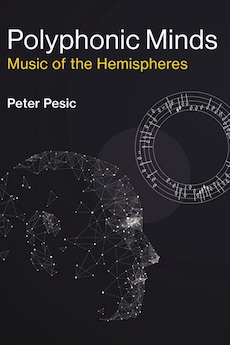By Svetlana Alpers
Peter Pesic is Director of the Science Institute and Musician–in-Residence at St. John’s College Santa Fe. The combination shows in his writings. In a series of distinctive books published by MIT, he has looked at, thought about, and listened to the world. Wandering between the sciences and the arts, he has addressed fascinating questions such as why the sky is (seen as) blue.
In this book he addresses polyphony, that is the simultaneous interweaving of several different musical lines or voices. The question this time is about the apparent unity of consciousness amidst multiple simultaneous experiences. Beginning with music widely considered, then settling into Europe and bit of America, he concludes by turning to neurology and the proposal of personhood as polyphony.
The book begins with music and thought in pages, which remind us how deeply music in early Western times was bound up with thought. In our time, performance is all, and what lies behind it is seldom discussed and is not likely to be recognized as philosophical in nature. Greek music itself was monophonic. But in writing, Plato and his music of the spheres was on the side of polyphony and Aristotle for monophony.
In the Christian world the double nature of Christ was to become a musical battleground. Some argued that polyphony suited the double nature. That was the practice of composers associated with Notre Dame in Paris in the twelfth and thirteenth centuries. Thomas Aquinas opposed polyphony as did many monastic denominations in centuries to come. And meanwhile secular canons, the earliest such written work being the still familiar “Sumer Is Icumen In,” were popular, and motets were sung featuring in one piece not only divers voices but also diverse languages. While many welcomed the cacophony, at one point the pope intervened with a ban of polyphony. These pages provide a kind social history of performance, for example describing polyphonic improvisation produced with the performers being like walking anthologies of memorized musical quotations. Not only philosophy, but also social history plays its part in the complex mix that is this book.
With the eventual triumph of polyphony, extraordinary works are produced and performed in certain instances as the projection of power. In the sixteenth century, the Medici featured a motet by Alessandro Striggio composed for forty independent voices. The page of the book on which the opening measures of this work are printed is as astounding to look at as it is impossible to imagine hearing. The threat of dissonance—that means slipping away from resolution or consonance—was always present, lurking in the wings. But a feature of polyphonic composition as it progressed was the intentional use of dissonance for expressive purposes, something particularly of use in the new musical form of opera.
But a philosophical problem about polyphony in the world remained, addressed most powerfully in 1617 by the astronomer Kepler. His Harmony of the Worlds is one of the most powerful defenses of polyphony ever written by a man who worried until the end about the fact that cosmic polyphony was so dissonant.
There is an illuminating chapter on Johann Sebastian Bach, cleverly titled “In Bach’s Hands.” First, matched to the materials in this book, the point is that Bach understood his works to be teachings and exemplars of human knowledge as well as being works of art. Then there is an interesting digression on the revolution Bach introduced by making the thumb, or rather two thumbs, necessary to keyboard playing. The expansion that that permitted is tied to a final point that his hands (and mind) worked towards freedom in composition. A gripping example of that is the manner in which Bach made polyphony out of the single line played by an unaccompanied string instrument. Leaping monophony, as Pesic calls it, creates an illusion of polyphony.
To hear for myself, I put on a CD of Bach’s Suite No. 6 for solo cello, which proceeds from a opening into a fugue that sounds like a fugue although the cello only occasionally plays more than one single note. Many voices in one. A solution perhaps to Kepler’s worry.
There is an advanced e-book edition of the book which allows examples to be played at a touch.
Svetlana Alpers, an artist, critic, and renowned art historian, is professor emerita of the history of art at the University of California, Berkeley and a visiting scholar in the Department of Fine Arts at New York University.




